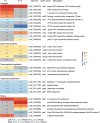Enhanced acid-stress tolerance in Lactococcus lactis NZ9000 by overexpression of ABC transporters
- PMID: 31409416
- PMCID: PMC6693162
- DOI: 10.1186/s12934-019-1188-8
Enhanced acid-stress tolerance in Lactococcus lactis NZ9000 by overexpression of ABC transporters
Abstract
Background: Microbial cell factories are widely used in the production of acidic products such as organic acids and amino acids. However, the metabolic activity of microbial cells and their production efficiency are severely inhibited with the accumulation of intracellular acidic metabolites. Therefore, it remains a key issue to enhance the acid tolerance of microbial cells. In this study, we investigated the effects of four ATP-binding cassette (ABC) transporters on acid stress tolerance in Lactococcus lactis.
Results: Overexpressing the rbsA, rbsB, msmK, and dppA genes exhibited 5.8-, 12.2-, 213.7-, and 5.2-fold higher survival rates than the control strain, respectively, after acid shock for 3 h at pH 4.0. Subsequently, transcriptional profile alterations in recombinant strains were analyzed during acid stress. The differentially expressed genes associated with cold-shock proteins (csp), fatty acid biosynthesis (fabH), and coenzyme A biosynthesis (coaD) were up-regulated in the four recombinant strains during acid stress. Additionally, some genes were differentially expressed in specific recombinant strains. For example, in L. lactis (RbsB), genes involved in the pyrimidine biosynthetic pathway (pyrCBDEK) and glycine or betaine transport process (busAA and busAB) were up-regulated during acid stress, and the argG genes showed up-regulations in L. lactis (MsmK). Finally, we found that overexpression of the ABC transporters RbsB and MsmK increased intracellular ATP concentrations to protect cells against acidic damage in the initial stage of acid stress. Furthermore, L. lactis (MsmK) consistently maintained elevated ATP concentrations under acid stress.
Conclusions: This study elucidates the common and specific mechanisms underlying improved acid tolerance by manipulating ABC transporters and provides a further understanding of the role of ABC transporters in acid-stress tolerance.
Keywords: ABC transporters; Acid-stress tolerance; Anti-acid components; Lactococcus lactis NZ9000; Transcriptomics.
Conflict of interest statement
The authors declare that they have no competing interests.
Figures






References
MeSH terms
Substances
Grants and funding
- 2017YFB0308401/the National Key Research and Development Program of China
- No. 111-2-06/the Program of Introducing Talents of Discipline to Universities
- KLIB-KF201706/the Open Project of Key Laboratory of Industrial Biotechnology, Ministry of Education, Jiangnan University
- LITE2018-08/the National First-class Discipline Program of Light Industry Technology and Engineering
LinkOut - more resources
Full Text Sources

